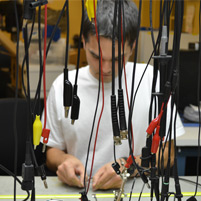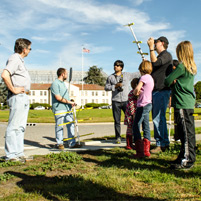Hamming It Up


Radio technology may have been around for more than a century, but that doesn't mean the old dog can't do new tricks.
Carnegie Mellon University "hams" — the popular shorthand for amateur radio operators — are sharing their expertise with a new generation of enthusiasts in Silicon Valley.
CMU's Moffett Field classrooms are a hotbed of radio activity that includes new research into mobile technology, connected embedded systems and smart communities — which all rely on radio frequencies.
Campus Director Bob Iannucci, Principal Research Scientist Martin Griss and David Witkowski, president of the Northern California Wireless Communications Alliance, led a five-week class last fall to prepare participants for the radio operator's license exam. Derek Kozel, a graduate student in electrical and computer engineering, assisted. About 20 students, faculty and alumni participated.
To support the students, faculty and affiliates in their experiments with radio as they develop novel uses combining wireless technology with computers and sensors, the team started the Wireless Innovators Club, CMU-SV's amateur radio association.
The Federal Communications Commission (FCC), which regulates U.S. radio operations, approved the club in 2013 with the call sign W6CMU. Radio and CMU go back a long way; the Carnegie Tech Radio Club, W3VC, was founded in 1914 and is the third-oldest student organization on the Pittsburgh campus.
Licensed amateur radio operators can transmit voice, video and data on specific channels, or bands, many of which can cross hundreds of miles with the use of antennas, repeaters and specialized receivers.
"Amateur radio operators have set up a significant amount of infrastructure that allows for communication between hams across the world," said Ervin Teng, a doctoral student who took the class and passed the technician and general exams. "It is a vibrant organization and community of people who use these bands for non-commercial, recreational or experimental use."
Combining a license with engineering experience allows CMU's grad students and faculty to explore new ways of working with radio tools that connect devices like cell phones and computers. They can also work with software-defined radio signals to provide even greater coverage.
"Amateur radio is one of my lifelong passions, and I'm very happy to establish this group on our campus," Iannucci said. "I look forward to seeing what the students and faculty can accomplish with support from CMU and the Wireless Innovators."
Local associations function as test labs and social organizations, and are active in emergency response planning. Iannucci, Griss and Witkowski are members of local community emergency response teams (CERT), and the CMU Disaster Management Initiative (DMI) has led several workshops and projects involving the use of radio in disaster preparation.
Two of the campus's major radio projects, the Survivable Social Network and CROSSMobile cell network, were developed with the DMI.
"Radio is incredibly important to engineers in many fields, especially those of us who rely on sharing data efficiently to create connected environments or innovate in the Internet of Things," said Griss, director of the DMI and a member of Mountain View CERT. "These are incredibly relevant skills for our students to learn and incorporate into their work."
Top photo: Derek Kozel working on his antenna in the CMU-SV campus RF lab. Photo by Rishik Dhar.
Bottom photo: The Feb. 22 fox hunt underway at CMU-SV's campus in the NASA Ames Research Park. Photo by by Sarah Stanek.
Related Links: CMU Silicon Valley | About Amateur Radio | W3VC.org
